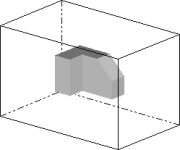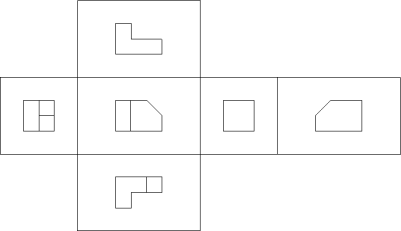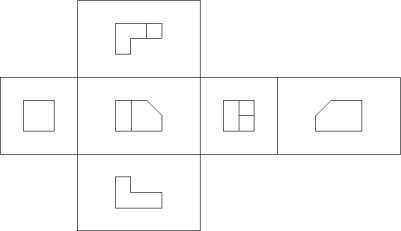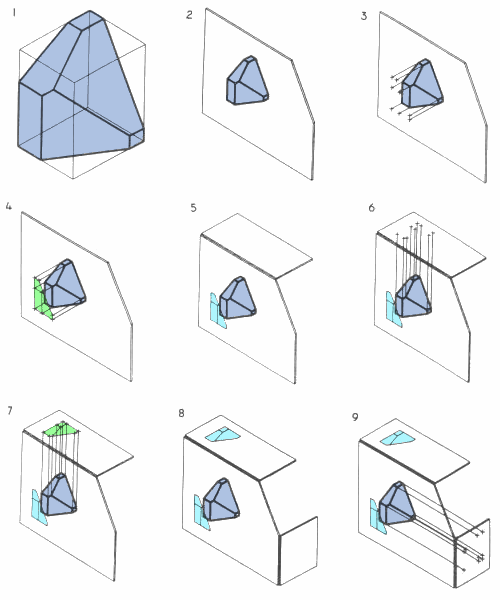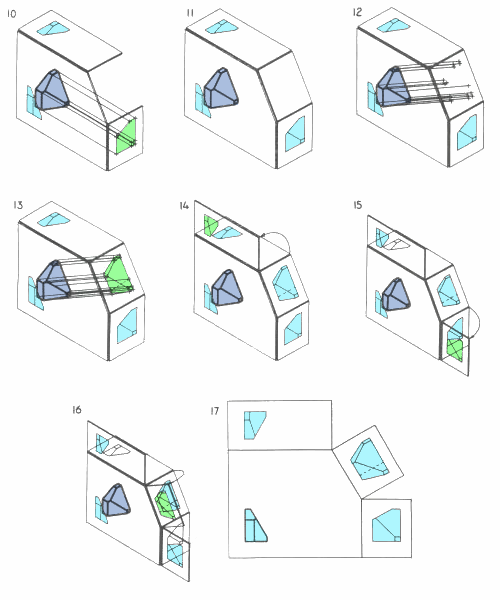Orthographic projection
|
|
This article is about technical drawings. See Orthographic projection (geometry) for linear transformations and Orthographic projection (cartography) for maps. For the language concept, see orthography.
Orthographic projection is a means of representing a three-dimensional object in two dimensions. It uses multiple views of the object, from points of view rotated about the object's center through increments of 90 degrees. Equivalently, the views may be considered to be obtained by rotating the object about its center through increments of 90 degrees.
The views are positioned relative to each other according to either of two schemes: first-angle or third-angle projection. In each, the appearances of views may be thought of as being projected onto planes that form a transparent "box" around the object:
| Contents |
First-angle projection
In first-angle projection, each view of the object is projected in the direction (sense) of sight of the object, onto the interior walls of the box:
First_angle_projecting.png
Image of object in box, with views of object projected in the direction of sight onto walls using first-angle projection
A two-dimensional representation of the object is then created by "unfolding" the box, to view all of the interior walls:
First_angle_unfolding.png
Similar image showing the box unfolding from around the object
Third-angle projection
In third-angle projection, each view of the object is projected opposite to the direction (sense) of sight, onto the (transparent) exterior walls of the box:
Third_angle_projecting.png
Image of object in box with views of object projected onto walls using third-angle projection
A two-dimensional representation of the object is then created by unfolding the box, to view all of the exterior walls.
Third_angle_unfolding.png
Similar image showing the box unfolding from around the object
Additional information
The term "third-angle" is used because, compared to "first-angle" projection, the directions of projection are rotated through two right angles about the object. Second-angle and fourth-angle projection also are defined, but do not result in useful images.
Third-angle projection is often considered to be more intuitive than first-angle projection.
While Third-Angle projections are prevalent in the USA and Canada, First-Angle projection is more popular in Europe and Asia.
Multiviews without rotation
Orthographic multiview projection is derived from the principles of descriptive geometry and may produce an image of a specified, imaginary object as viewed from any direction of space. Orthographic projection is distinguished by parallel projectors emanating from all points of the imaged object and which intersect a plane of projection at right angles. Above, a technique is described that obtains varying views by projecting images after the object is rotated to a desired position.
Descriptive geometry customarily relies on obtaining various views by imagining an object to be stationary, and changing the direction of projection (viewing) in order to obtain the desired view.
See Figure one. Using the rotation technique above, note that no orthographic view is available looking perpendicularly at any of the inclined surfaces. Suppose a technician desired such a view to, say, look through a hole to be drilled perpendicularly to the surface. Such a view might be desired for calculating clearances or for dimensioning purposes. To obtain this view without multiple rotations requires the principles of Descriptive Geometry. The steps below describe the use of these principles in a typical example. Third angle projection is used here because it is the predominant choice in the US. (First angle projection is used predominantly in Europe but its use there is decreasing.)
- Fig.1: Pictorial of imaginary object that the technician wishes to image.
- Fig.2: The object is imagined behind a vertical plane of projection. The angled corner of the plane of projection is addressed later.
- Fig.3: Projectors emanate parallel from all points of the object, perpendicular to the plane of projection.
- Fig.4: An image is created thereby.
- Fig.5: A second, horizontal plane of projection is added, perpendicular to the first.
- Fig.6: Projectors emanate parallel from all points of the object perpendicular to the second plane of projection.
- Fig.7: An image is created thereby.
- Fig.8: A third plane of projection is added, perpendicular to the previous two.
- Fig.9: Projectors emanate parallel from all points of the object perpendicular to the third plane of projection.
- Fig.10: An image is created thereby.
- Fig.11: A fourth plane of projection is added parallel to the chosen inclined surface, and per force, perpendicular to the first (Frontal) plane of projection.
- Fig.12: Projectors emanate parallel from all points of the object perpendicularly from the inclined surface, and per force, perpendicular to the fourth (Auxiliary) plane of projection.
- Fig.13: An image is created thereby.
- Fig.14-16: The various planes of projection are unfolded to be planar with the Frontal plane of projection.
- Fig.17: The final appearance of an orthographic multiview projection and which includes an Auxiliary View showing the true shape of an inclined surface.
Pictorials
Within Orthographic projection there is an ancillary category known as Pictorials. Pictorials show an image of an object as viewed from a skew direction in order to reveal all three directions (axes) of space in one picture. Orthographic pictorial, rote, instrument drawings are often used to approximate Graphical Perspective projections, but there is attendant distortion in the approximation. Because Pictorial projections innately have this distortion, in the rote, instrument drawing of Pictorials, great liberties may then be taken for economy of effort and best effect. Orthographic Pictorials rely the technique of axonometric projection ("to measure along axes").

